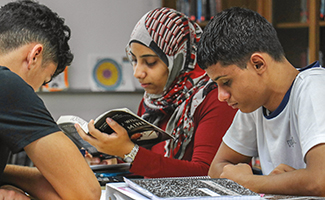Leading Literacy Across the Disciplines
November 01, 2019
Districts in Maryland and Michigan start small with a WestEd program to build content-area learning in the upper grades

Results were immediate for the 9th graders. By the end of 2018-19, 87 percent of the 46 students who completed the reading support course showed growth on the district’s electronic reading inventory. Nearly 90 percent of 9th graders responding to a survey found Reading Apprenticeship to be more helpful than their middle school reading interventions.
In Washington County, the high school teachers collaborated with administrators to identify a group of 9th graders performing at least two years below grade level. These students participated in a full-year Reading Apprenticeship Academic Literacy course taught by the reading intervention teacher with coaching support from Reading Apprenticeship’s national facilitators. The students also participated in English, history and science classes in which teachers used the literacy routines learned through the professional development.
A Maryland Program
Reading Apprenticeship shows how teachers can build on secondary students’ personal strengths and enthusiasm for social interaction to develop the cognitive skills and knowledge necessary to engage with rigorous content in science, history, English language arts and math. Metacognitive conversation — making thinking visible — links these four dimensions together as students engage in extensive reading.
Reading Apprenticeship, developed over three decades by Ruth Schoenbach, Cynthia Greenleaf and their WestEd colleagues, provides an evidence-based approach for addressing the disciplinary literacy challenge. The framework (see figure, below) offers a coherent guide for supporting students’ increased independence as learners and for developing their knowledge and skills in the content areas.
Maryland, a local control state, recently sponsored WestEd’s Reading Apprenticeship regional professional development institutes because the evidence-based approach addresses the literacy challenge facing students in high school subjects.
In summer 2018, district leadership strategically selected a four-teacher, 9th-grade team to participate in a series of Reading Apprenticeship professional development sessions sponsored by the Maryland State Department of Education. These teachers discovered a new approach for developing student learning communities and building students’ literacy skills to support content-area learning.
Faced with the question, “How can we impact more secondary school students who are struggling readers?,” administrators in Maryland’s Washington County Public Schools decided to start small with cross-disciplinary literacy.
Participants also reported an increased sense of efficacy. One reflected on her experience this way: “Being in this program/class has helped me understand what I’m reading and makes me want to read more books.” Teachers corroborated this impact. One noted, “The program is especially meaningful to social studies instruction. Never before have I seen the kind of engagement, deep discussion and collaboration amongst my students at this point in the year until I started using this program.”
By starting with a coherent focus, the Washington County team spurred fellow educators’ enthusiasm for Reading Apprenticeship. This past summer, an additional 52 teachers voluntarily participated in the professional development, and the district intends to gradually expand the program with five additional schools conducting pilots during 2019-20.
Secondary Literacy
In 2017, the National Assessment of Educational Progress found that only 36 percent of all 8th graders could read at the proficient level or above. Nearly two-thirds of secondary school students are unprepared for the demands of high school academic work, especially reading and comprehending complex texts and synthesizing information from multiple sources.
Literacy plays a central role in learning across disciplines. And, the nature of reading varies from discipline to discipline. In biology, students may be asked to use data about the growth of staph infections in hospitals and diagrams outlining natural selection processes to explain why resistant strains of bacteria explode. This science literacy task requires different strategies and background knowledge from a history task, such as one that requires the interpretation of multiple, conflicting primary sources about the removal of the Cherokees from Georgia.
Increasingly complex literacy demands in different subject areas mean that it becomes ever more difficult for students to keep up. Researchers have identified this as one of the most common reasons students drop out of high school
Frustrated by the gap between students’ entering literacy skills and the demands of complex disciplinary texts, secondary teachers often develop workarounds that circumvent students grappling with reading and critical thinking. Compounding this is the pressure teachers feel to cover the content assembled in curriculum guides and tested on high-stakes assessments. Teachers’ own learning experiences and district pacing guides, intended to ensure rigor and equitable access, reinforce this emphasis. Coverage leaves little time for collaborating with linguistically and culturally diverse peers to understand complex concepts and texts.
Furthermore, teachers often don’t have the pedagogical tools for simultaneously building students’ academic literacy skills and engaging them in rigorous disciplinary content. Together, these challenges mean that teachers rather than students do most of the classroom work, resulting in students being unprepared to face the literacy demands of college and career. To make headway, teachers need a vision of workable solutions and an expanded instructional repertoire that actively engages students in reading authentic disciplinary texts.
A Michigan Example
In Dearborn, Mich., Fordson High School — home to the largest Arabic-speaking population outside the Middle East — has invested in supporting Reading Apprenticeship for nearly a decade. Fordson’s approach to scaling up Reading Apprenticeship focuses on integrating the framework and routines into all regular subject-area classrooms and there-fore doesn’t require special scheduling. Mature Reading Apprenticeship classrooms illustrate what the framework looks like in action.
In teacher Julie Jamieson’s 10th-grade English class, students wrestled with key language arts concepts — inference and metaphor — using Billie Holiday’s Strange Fruit, historical photographs of lynchings and To Kill a Mockingbird. Students worked collaboratively to interpret these texts while Jamieson probed learning with metacognitive and cognitive questions: “Why do you think that?” “What does her voice add?”
Similarly, in teacher Sanaa Ayoub’s 11th-grade psychology class, students individually and collaboratively read a journal article about new experimental evidence related to the effects of marijuana on adolescent brains. Together, students answered their guiding inquiry question, “Should marijuana be federally legalized?”
Ayoub modeled her own practice as a reader of psychology, noting terms she didn’t understand, sharing how she analyzed words and pointing out features of research articles. By the end of the class, students had both identified the strongest evidence and added to their reading strategies repertoire.
In Reading Apprenticeship classrooms, students access complex texts, grapple with key disciplinary concepts, develop discipline-specific reading skills and build their ability to collaborate with their peers around content. Together these features can
have a significant impact on student performance.

Supporting Coherence
Many schools and districts wrestle with integrating multiple reforms. Reading Apprenticeship supports coherence by offering professional development that enables teachers to integrate core literacy routines into their existing curricula.
The Fordson High School classrooms illustrate this principle. In the English language arts classroom, the teacher selected two texts that were more accessible to scaffold her students’ understanding of inference in the required novel. In the psychology classroom, the teacher extended students’ understanding of how the brain works by having them read an article for researchers related to a high-interest topic.
Educators today face multiple demands — including rigorous state standards, teacher evaluation frameworks, and curriculum and textbook adoptions. Centennial School District in Gresham, Ore., has faced exactly this. Rita Ramstad, Centennial’s district media coordinator and a secondary school instructional coach, developed a document illustrating connections between the Danielson framework, the Common Core and Reading Apprenticeship. “Teachers and administrators were feeling overwhelmed by the number of new things on their plates,” Ramstad says, “and the document helped them see that none of the things function separately from the others and all are essential to meeting our goal of higher achievement for all students.”
To support disciplinary literacy, administrators can actively work to increase coherence. Fordson’s administrators invest in internal coaching that helps teachers integrate disciplinary literacy routines into their classrooms. Centennial supported the development of the crosswalk, which includes one column summarizing Danielson framework indicators, a second which includes Reading Apprenticeship and Common Core indicators, and a third which identifies specific artifacts and activities to serve as practice-based evidence. The district also integrated these ideas into walk-throughs.
Learning Impact
While supporting secondary students in simultaneously learning disciplinary knowledge and literacy skills represents a huge challenge, strong professional development and evidence-based instructional strategies can help teachers achieve these goals. Reading Apprenticeship’s research base earned a strong rating on the Evidence for ESSA website. Multiple studies show that students in Reading Apprenticeship classrooms outperform students in non-Reading Apprenticeship classrooms on state English language arts tests as well as disciplinary literacy assessments.
As Jodi Smith, Washington County’s secondary literacy achievement coordinator, reflects, “If you want to help your striving readers, you can find success. … We have proof.”
About the Authors
- Linda Friedrich is director of the strategic literacy initiative at WestEd in San Francisco, Calif. Twitter: @LindaFriedrich1.
- Sharon Saez is partnership development director of the strategic literacy initiative at WestEd.
- Mary Stump is associate director of strategic literacy initiative at WestEd.
Additional Resources
The authors suggest these resources for supporting literacy learning across the disciplines.
BOOKS/ARTICLE
Leading for Literacy:
A Reading Apprenticeship Approach by Ruth Schoenbach, Cynthia Greenleaf and Lynn Murphy supports leadership teams as they build cultures of academic literacy engagement and improvement. It includes district approaches to implementation.
Reading for Understanding: How Reading
Apprenticeship Improves Disciplinary Learning in Secondary and College
Classrooms by Ruth Schoenbach, Cynthia Greenleaf and Lynn Murphy presents a coherent framework for improving the reading and subject-area learning of all secondary students in all disciplines.
“Teaching Disciplinary Literacy to Adolescents: Rethinking Content-Area Literacy” by Timothy Shanahan and Cynthia Shanahan, Harvard Educational Review, April 2008. Oft-cited article on the what and why of disciplinary literacy.
VIDEO
Ed-Talk: Developing Youth Literacies by Elizabeth Birr Moje, University of Michigan. This seven-minute talk provides a rationale for why disciplinary literacy matters based on Moje’s 12-year longitudinal study of youth literacy inside and outside school.
WEBSITES
This website created by the Center for Research and Reform in Education at Johns Hopkins University reviews and ranks programs, helping districts find programs that match their needs
while meeting ESSA evidence standards.
This website provides videos of teacher practices, research studies, book chapters and other resources relating to the Reading Apprenticeship program developed at WestEd.
Advertisement
Advertisement
Advertisement
Advertisement



